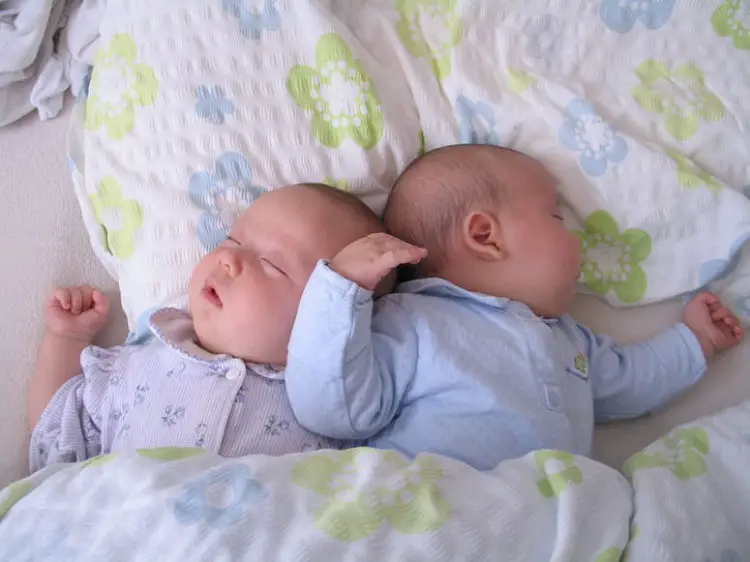Having a baby is a beautiful thing, but the Joy of having twins is immeasurable. Unfortunately, it’s quite an uphill climb because they require extra work at every age and stage.
Taking care of twins is not an easy task, especially if you’re a first-time mom who just had twins for the first time. You may start asking yourself, How do I sleep train twins?
Don’t worry; this article will be teaching you in clear terms on how to sleep train twins, tips to keep in mind when sleep training twins.
When Can You Start Sleep Training Twins?
As long as your little cuties are healthy, there is no particular time for sleep training; Sleep training twins isn’t very different from that of single babies.
Sleep training your baby can help them sleep peacefully through the night, thereby allowing you to function like a normal human being again.
Here are some guidelines to help you decide what age to sleep train your twins.
While these are general age categories, if you had your twins pre-maturely, you must go by their adjusted age to determine when it is appropriate to start your sleep training program. It has to be when they can actually self-soothe and fall asleep independently.
Newborns
The main thing that is of paramount importance in the lives of newborns for the first two months of their existence is for them to bond with their parents,
During this period, it’s best advised to hold off on sleep training and rather focus on getting to know your babies and different their personalities.
At 2 to 4 Months
Age this time, it is possible to sleep train your twins, but it will probably not be easy. At this stage, many children are still waking up often to eat, so the chances of them getting enough sleep through the night is low.
At 4 to 6 Months
According to experts, this period is the best time to start sleep training your twins.
While the four-month sleep regression can draw you back a few weeks, at this period, babies are starting to drop their nighttime feedings, self soothe and fall asleep independently.
Babies, this age can’t be able to move around independently or able to pull themselves up and out of their cribs, which can make it difficult to sleep train if you wait.
At 7 Months or Older
If you didn’t sleep train between the 4-to-6-month marks, you might be concerned that you’ve missed the opportunity. Your little ones might be pulling up, crawling, possibly climbing out of their cribs.
They might even be reaching the 8-to-10-month sleep regression, making you even more tired. Please don’t give up, and it is not too late to sleep train your twins.
It might take patience, a little more effort, and a few more trips to put your babies back into their cribs.
Related Post: How To Get Your Baby To Sleep Without Being Held
Can Twins Be Sleep Trained In The Same Room?
Sleep training your little cuties in the same room; if your home’s size is big enough to accommodate it, then why not.
Also, if you want your twins to share the same room as they grow, you ought to sleep train them together.
If your twins have been sharing the same space and are used to it, then it is ideal to be sleep trained together.
There are situations where you can’t help but sleep train them separately, especially if one baby is a better sleeper than the other as a result of individual differences.
You will surely find out that one of the twins may be waking up the other very often. In this situation, take the better sleeper out of the room if you have extra space and sleep train them separately.
Also, if one of the twins seems inconsolable or the two of them keep waking each other no matter how much you try, then you should sleep train them separately.
Methods On How To Sleep Train Twins
There are lots of sleep training methods you can choose from, and they include;
1. Fading
This involves the gradual fading out of comfort and support for your twins at bedtime. You start with the same amount of support you always give; then you reduce the amount of time, then you get to the point where you no longer need to soothe them to sleep.
2. No Tears
This method involves following the pace determined by your baby. It involves techniques like rocking your babies to sleep, introducing a lovey, or sometimes co-sleeping to bring your babies comfort.
You can also comfort your babies to the point of drowsiness and then lay them on their bed, allowing them to fall asleep independently. If they start to cry, go in and comfort them and lay them down again once they are soothed.
3. Pick Up, Put Down
It involves allowing your baby to cry a bit, and then you swing into the action of comforting them to help them get used to sleeping on their own.
But, bear in mind in you don’t just leave to go into the kitchen and start drinking your favorite wine you’ve missed all day.
Instead, what you do is, wait outside the bedroom door or take a baby monitor along with you and pay close attention to what your twins do next.
Do not run in right away if you hear them fussing or crying. Instead, take a moment to listen. If they happen to be calming themselves down?
That’s good news; let them self-soothe! If it’s the opposite, or they start to get fussier, feel free to go in and pick up your babies.
4. Ferber Method
This method was created by Richard Ferber, the founder of the Center of Pediatric Sleep Disorders in Boston.
This method does not fully call for crying it out. However, it does allow your baby to cry a bit more than the previous methods.
In this method, you put the babies in their cribs while awake. Then gradually you leave them for a more extended period, even when they are crying, you only go in to comfort them but not pick them up or feed them.
The progressive waiting, as Ferber calls it, teaches babies to soothe themselves and fall asleep on their own.
Tips For Sleep Training Twins

Sleeping training a single baby can be hectic, not to talk of twins. It simply means that you need to wear patience as apparel around you, but with time and perseverance, success will become your second name.
Here are some valuable tips on how to sleep, train twins
1. Do Double Duty Feeding
It is a known fact that babies who feed simultaneously get drowsy, so to be successful with your sleep training program, place both babies on the same feeding schedule first.
This will enhance their tendencies to fall asleep almost simultaneously, and it aids with your sleep training plan.
2. Watch for Sleep Signs
When your babies have been fed, and you have burped and changed them, the next signal to look for is sleep cues like yawning and rubbing of the eyes, putting them down drowsy but awake in their respective crib while following safe sleep guidelines.
3. Coordinate Twin Naps
The American Academy of Pediatrics (AAP) recommends that twins sleep on different surfaces but that doesn’t stop them from taking naps simultaneously.
Even if one twin takes a longer time, ensure that their naps are taken simultaneously. It will aid the sleep training schedule.
4. Wake A Sleeping Twin If The Other Is Up For A Feeding
Remember that the first tip is to feed both babies simultaneously, so stick to that, even when it is painful and inconvenient.
Do so by gently waking up the sleeping baby. The essence is to help them fall asleep at the same time.
5. Create A Solid Bedtime Routine
There is a need for a consistent bedtime routine; making them fall asleep simultaneously is paramount in the sleep training schedule.
Start with a time for rocking them to sleep, take them to their rooms, and dim the light while you read storybooks or try lullabies.
You can offer a feeling of comfort and warmth before bedtime feeding. Repeat the same routine every night so that your babies become adapted to that particular timing as bedtime.
6. Divide and Conquer
If one of your twins sleeps all through the night, let him/her snooze in a different room from his sibling in the meantime, even if it means moving her crib or playard into the kitchen or bathroom. By doing this, the nighttime wakings of the baby won’t give her a case of the midnight cranks, too.
7. White Noise
White noise is effective no matter how many babies you are trying to sleep train. This trick can be employed next to your babies if they are sharing a crib, and some parents even double or triple the power by putting babies into separate cribs.
Place one machine next to each crib and a fan between the two to help block out one of the twins from waking the other.
White noise can also play a huge role in:
- Reducing stress: White noise can play a huge role in blocking out the noises and actions that are going on around your baby. This trick helps them relax and sleep better at night.
- Help babies sleep longer: Blocking out the noises and actions outside of your babies’ door will help them stress less, but it can also help them sleep longer in the night. As you may know, babies have internal alarm clocks that regulate them in and out of a deep sleep cycle. When a baby is in a lighter part of its sleep cycle, it is easier to startle or wake the baby up. Interestingly, white noise functions by softening this internal alarm clock but also helps block out the noise.
8. Write It All Down
I don’t know how any family with two or more babies can make it through a day without writing everything down, but I’m surprised that some parents don’t!
Wow! I have to jot things down with when I first had my baby, or I forget what time they woke up, what time I have to put them down, etc.
Once you’ve decided to make sleep a priority, focus on creating healthy sleep habits for your babies. Keeping a sleep log is of utmost importance.
This will help you see patterns, progress where things need to be tweaked and helps you to stay on top of the game. On my sleep logs, I recommend parents include:
- Morning wake-up time
- All feedings (breast/bottle/solids)
- Mood before baby naps (happy, tired, fussy, alert, yawning, etc.)
- Put downtimes for naps, asleep times, and wake-up times
- Mood upon wake-up from sleep (did they wake up Crying? Happy? Or Fussing?)
- Bedtime put down and asleep time
- Any night wakings, night feedings, sleep-cries
Here is a short video teaching you how to sleep train with twins
Read Also: 7 Best Twin Carriers For Parents
Wind Up
I hope this article has sufficiently provided you with valuable methods on how to sleep train twins and some practical tips to keep in mind when sleep training your babies.
Remember, sleep training twins requires a flexible approach, so be prepared to adjust when you need to and try different tactics.
It may take some time for twins to sleep train, but don’t worry, be patient, and know that your sweet babies will soon join their singleton cousins and quickly sleep like champs. I wish you success as you embark on your sleep training program.
